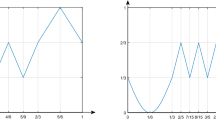Abstract
A definition of topological entropy for a free semigroup action is suggested. Suppose that a free semigroup acts on a compact metric space by continuous self-maps. To this action, we assign a skew-product transformation whose fiber entropy is taken to be the entropy of the initial action. The main result is Theorem 1, a topological analogue of the Abramov–Rokhlin formula.
Similar content being viewed by others
References
A. A. Kirillov, Dynamical systems, factors and group representations. Russ. Math. Surv. 22 (1967), No. 5, 67–80.
J. P. Conze, Entropie d'un groupe abélien de transformations. Z. Wahrscheinlichkeitstheorie und verwandte Gebiete 25 (1972), No. 1, 11–30.
Y. Katznelson and B. Weiss, Commuting measure-preserving transformations. Israel J. Math. 12 (1972) No. 2, 161–173.
A. M. Stepin and A. T. Tagi-Zade, Variational characterization of topological pressure for amenable groups of transformations. Dokl. Akad. Nauk SSSR 254 (1980), No. 3, 545–549.
R. Burton, K. Dajani, and R. Meester, Entropy for random group actions. Ergod. Theory and Dynam. Syst. 18 (1998) 109–124.
A. Katok and B. Hasselblatt, Introduction to the Modern Theory of Dynamical Systems. Cambridge Univ. Press, 1997.
Author information
Authors and Affiliations
Rights and permissions
About this article
Cite this article
Bufetov, A. Topological Entropy of Free Semigroup Actions and Skew-Product Transformations. Journal of Dynamical and Control Systems 5, 137–143 (1999). https://doi.org/10.1023/A:1021796818247
Issue Date:
DOI: https://doi.org/10.1023/A:1021796818247



